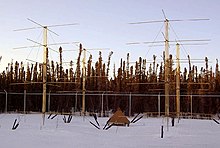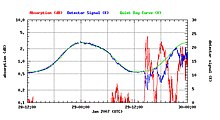
The ionosphere is the ionized part of the upper atmosphere of Earth, from about 48 km (30 mi) to 965 km (600 mi) above sea level, a region that includes the thermosphere and parts of the mesosphere and exosphere. The ionosphere is ionized by solar radiation. It plays an important role in atmospheric electricity and forms the inner edge of the magnetosphere. It has practical importance because, among other functions, it influences radio propagation to distant places on Earth. It also affects GPS signals that travel through this layer.

Microwave is a form of electromagnetic radiation with wavelengths ranging from about 30 centimeters to one millimeter corresponding to frequencies between 1 GHz and 300 GHz respectively. Different sources define different frequency ranges as microwaves; the above broad definition includes UHF, SHF and EHF bands. A more common definition in radio-frequency engineering is the range between 1 and 100 GHz. In all cases, microwaves include the entire SHF band at minimum. Frequencies in the microwave range are often referred to by their IEEE radar band designations: S, C, X, Ku, K, or Ka band, or by similar NATO or EU designations.
Cosmic noise, also known as galactic radio noise, is not actually sound, but a physical phenomenon derived from outside of the Earth's atmosphere. It can be detected through a radio receiver, which is an electronic device that receives radio waves and converts the information given by them to an audible form. Its characteristics are comparable to those of thermal noise. Cosmic noise occurs at frequencies above about 15 MHz when highly directional antennas are pointed toward the Sun or other regions of the sky, such as the center of the Milky Way Galaxy. Celestial objects like quasars, which are super dense objects far from Earth, emit electromagnetic waves in their full spectrum, including radio waves. The fall of a meteorite can also be heard through a radio receiver; the falling object burns from friction with the Earth's atmosphere, ionizing surrounding gases and producing radio waves. Cosmic microwave background radiation (CMBR) from outer space is also a form of cosmic noise. CMBR is thought to be a relic of the Big Bang, and pervades the space almost homogeneously over the entire celestial sphere. The bandwidth of the CMBR is wide, though the peak is in the microwave range.

Radio waves are a type of electromagnetic radiation with the longest wavelengths in the electromagnetic spectrum, typically with frequencies of 300 gigahertz (GHz) and below. At 300 GHz, the corresponding wavelength is 1mm, which is shorter than the diameter of a grain of rice. At 30 Hz the corresponding wavelength is ~10,000 kilometers, which is longer than the radius of the Earth. Wavelength of a radio wave is inversely proportional to its frequency, because its velocity is constant. Like all electromagnetic waves, radio waves in a vacuum travel at the speed of light, and in the Earth's atmosphere at a slightly slower speed. Radio waves are generated by charged particles undergoing acceleration, such as time-varying electric currents. Naturally occurring radio waves are emitted by lightning and astronomical objects, and are part of the blackbody radiation emitted by all warm objects.

High frequency (HF) is the ITU designation for the range of radio frequency electromagnetic waves between 3 and 30 megahertz (MHz). It is also known as the decameter band or decameter wave as its wavelengths range from one to ten decameters. Frequencies immediately below HF are denoted medium frequency (MF), while the next band of higher frequencies is known as the very high frequency (VHF) band. The HF band is a major part of the shortwave band of frequencies, so communication at these frequencies is often called shortwave radio. Because radio waves in this band can be reflected back to Earth by the ionosphere layer in the atmosphere – a method known as "skip" or "skywave" propagation – these frequencies are suitable for long-distance communication across intercontinental distances and for mountainous terrains which prevent line-of-sight communications. The band is used by international shortwave broadcasting stations (3.95–25.82 MHz), aviation communication, government time stations, weather stations, amateur radio and citizens band services, among other uses.
Radio propagation is the behavior of radio waves as they travel, or are propagated, from one point to another in vacuum, or into various parts of the atmosphere. As a form of electromagnetic radiation, like light waves, radio waves are affected by the phenomena of reflection, refraction, diffraction, absorption, polarization, and scattering. Understanding the effects of varying conditions on radio propagation has many practical applications, from choosing frequencies for amateur radio communications, international shortwave broadcasters, to designing reliable mobile telephone systems, to radio navigation, to operation of radar systems.
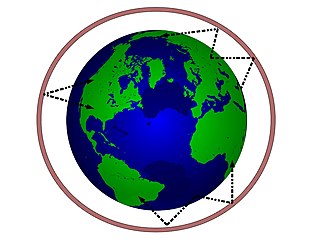
In radio communication, skywave or skip refers to the propagation of radio waves reflected or refracted back toward Earth from the ionosphere, an electrically charged layer of the upper atmosphere. Since it is not limited by the curvature of the Earth, skywave propagation can be used to communicate beyond the horizon, at intercontinental distances. It is mostly used in the shortwave frequency bands.

In physics, absorption of electromagnetic radiation is how matter takes up a photon's energy — and so transforms electromagnetic energy into internal energy of the absorber.
Plasma stealth is a proposed process to use ionized gas (plasma) to reduce the radar cross-section (RCS) of an aircraft. Interactions between electromagnetic radiation and ionized gas have been extensively studied for many purposes, including concealing aircraft from radar as stealth technology. Various methods might plausibly be able to form a layer or cloud of plasma around a vehicle to deflect or absorb radar, from simpler electrostatic or radio frequency discharges to more complex laser discharges. It is theoretically possible to reduce RCS in this way, but it may be very difficult to do so in practice. Some Russian missiles e.g. the 3M22 Zircon (SS-N-33) and Kh-47M2 Kinzhal missiles have been reported to make use of plasma stealth.
The 80-meter or 3.5 MHz band is a band of radio frequencies allocated for amateur radio use, from 3.5 to 4.0 MHz in IARU Region 2, and generally 3.5 to 3.8 or 3.9 MHz in Regions 1 and 3 respectively. The upper portion of the band, which is usually used for phone (voice), is sometimes referred to as 75 meters. In Europe, 75m is a shortwave broadcast band, with a number of national radio services operating between 3.9 and 4.0 MHz.
Non-line-of-sight (NLOS) radio propagation occurs outside of the typical line-of-sight (LOS) between the transmitter and receiver, such as in ground reflections. Near-line-of-sight conditions refer to partial obstruction by a physical object present in the innermost Fresnel zone.
Near vertical incidence skywave, or NVIS, is a skywave radio-wave propagation path that provides usable signals in the medium distances range — usually 0–650 km. It is used for military and paramilitary communications, broadcasting, especially in the tropics, and by radio amateurs for nearby contacts circumventing line-of-sight barriers. The radio waves travel near-vertically upwards into the ionosphere, where they are refracted back down and can be received within a circular region up to 650 km from the transmitter. If the frequency is too high, refraction is insufficient to return the signal to earth and if it is too low, absorption in the ionospheric D layer may reduce the signal strength.

In radio reception, radio noise is unwanted random radio frequency electrical signals, fluctuating voltages, always present in a radio receiver in addition to the desired radio signal. Radio noise near in frequency to the radio signal being received interferes with it in the receiver's circuits. Radio noise is a combination of natural electromagnetic atmospheric noise created by electrical processes in the atmosphere like lightning, manmade radio frequency interference (RFI) from other electrical devices picked up by the receiver's antenna, and thermal noise present in the receiver input circuits, caused by the random thermal motion of molecules.
A sudden ionospheric disturbance (SID) is any one of several ionospheric perturbations, resulting from abnormally high ionization/plasma density in the D region of the ionosphere and caused by a solar flare and/or solar particle event (SPE). The SID results in a sudden increase in radio-wave absorption that is most severe in the upper medium frequency (MF) and lower high frequency (HF) ranges, and as a result often interrupts or interferes with telecommunications systems.
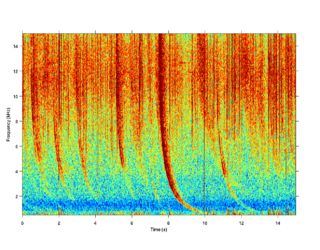
A radio atmospheric signal or sferic is a broadband electromagnetic impulse that occurs as a result of natural atmospheric lightning discharges. Sferics may propagate from their lightning source without major attenuation in the Earth–ionosphere waveguide, and can be received thousands of kilometres from their source. On a time-domain plot, a sferic may appear as a single high-amplitude spike in the time-domain data. On a spectrogram, a sferic appears as a vertical stripe that may extend from a few kHz to several tens of kHz, depending on atmospheric conditions.
This is an index to articles about terms used in discussion of radio propagation.
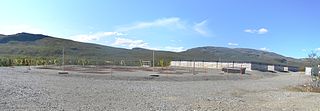
The Kilpisjärvi Atmospheric Imaging Receiver Array (KAIRA) is an astronomical observatory operated by the Sodankylä Geophysical Observatory on behalf of Oulu University. It is located at Kilpisjärvi, Enontekiö near the border with Norway. It comprises two LOFAR-derived radio telescope systems and is capable of observing at HF and VHF radio frequencies. It is used for atmospheric, near-Earth space and astronomical research. KAIRA uses LOFAR phased-array antennas and digital signal-processing hardware. The phased array configuration has no moving parts and with digital control, allows KAIRA to quickly scan the sky, giving KAIRA a large field of view. KAIRA can produce a continuous all-sky image of the radio transparency of ionosphere, using cosmic radio noise for "illumination" (riometry). KAIRA can also obtain electron density profiles in the atmosphere. This allows the study of the interaction of the solar wind with the atmosphere, such as in aurora borealis and other space weather phenomena. In addition to near-space imaging, the use of KAIRA has been demonstrated for long-baseline interferometry observations of pulsars.
One way of outlining the subject of radio science is listing the topics associated with it by authoritative bodies.

Explorer 20, also known Ionosphere Explorer-A, IE-A, S-48, TOPSI and Topside Explorer, was a NASA satellite launched as part of Explorer program. Its purpose was two-fold: long-term investigation of the ionosphere from above, and in situ investigation of ion concentrations and temperatures.

Explorer 38 was the first NASA satellite to study Radio astronomy. Explorer 38 was launched as part of the Explorer program, being the first of the 2 RAE-satellites. Explorer 38 was launched on 4 July 1968 from Vandenberg Air Force Base, California, with a Delta J launch vehicle.
